Pricing Guides & Dictionary of Makers Marks for Antiques & Collectibles

A few examples of appraisal values for
COCKSPUR
Search our price guide for your own treasures
-
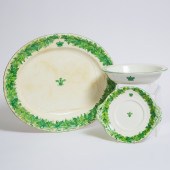 Tureen Stand, Vegetable Dish and
Tureen Stand, Vegetable Dish and a Large Platter Made for Albert, Prince of Wales's Visit to Canada, Kerr and Binns, 1860 with green over-painted transfer decoration including the Prince of Wales plumed crest under the coronet of the prince consort, all within a maple leaf wreath border, and with impressed makers and PODR marks and retailer's transfer mark for Sharpus & Co., 13 Cockspur St., London, verso platter 14.3 x 17 in — 36.3 x 43.2 cm
Tureen Stand, Vegetable Dish and
Tureen Stand, Vegetable Dish and a Large Platter Made for Albert, Prince of Wales's Visit to Canada, Kerr and Binns, 1860 with green over-painted transfer decoration including the Prince of Wales plumed crest under the coronet of the prince consort, all within a maple leaf wreath border, and with impressed makers and PODR marks and retailer's transfer mark for Sharpus & Co., 13 Cockspur St., London, verso platter 14.3 x 17 in — 36.3 x 43.2 cm -
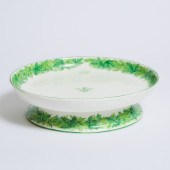 Large Worcester Low Centrepiece
Large Worcester Low Centrepiece Comport Made for Albert, Prince of Wales's Visit to Canada, Kerr and Binns, 1860 with green over-painted transfer decoration including the Prince of Wales plumed crest under the coronet of the prince consort, all within a maple leaf wreath border, and with retailer's transfer mark for Sharpus & Co., 13 Cockspur St., London, verso height 3 in — 7.6 cm, diameter 11 in — 27.9 cm
Large Worcester Low Centrepiece
Large Worcester Low Centrepiece Comport Made for Albert, Prince of Wales's Visit to Canada, Kerr and Binns, 1860 with green over-painted transfer decoration including the Prince of Wales plumed crest under the coronet of the prince consort, all within a maple leaf wreath border, and with retailer's transfer mark for Sharpus & Co., 13 Cockspur St., London, verso height 3 in — 7.6 cm, diameter 11 in — 27.9 cm -
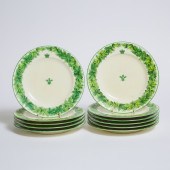 Eleven Worcester Dessert Plates
Eleven Worcester Dessert Plates Made for Albert, Prince of Wales's Visit to Canada, Kerr and Binns, 1860 each with green overpainted transfer decoration including the Prince of Wales plumed crest under the coronet of the prince consort, all within a maple leaf wreath border, and with impressed makers and PODR marks and retailer's transfer mark for Sharpus & Co., 13 Cockspur St., London, verso each diameter 8 in — 20.3 cm
Eleven Worcester Dessert Plates
Eleven Worcester Dessert Plates Made for Albert, Prince of Wales's Visit to Canada, Kerr and Binns, 1860 each with green overpainted transfer decoration including the Prince of Wales plumed crest under the coronet of the prince consort, all within a maple leaf wreath border, and with impressed makers and PODR marks and retailer's transfer mark for Sharpus & Co., 13 Cockspur St., London, verso each diameter 8 in — 20.3 cm -
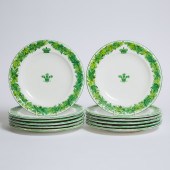 Twelve Worcester Dinner Plates Made
Twelve Worcester Dinner Plates Made for Albert, Prince of Wales's Visit to Canada, Kerr and Binns, 1860 each with green over-painted transfer decoration including the Prince of Wales plumed crest under the coronet of the prince consort, all within a maple leaf wreath border, and with impressed makers and PODR marks and retailer's transfer mark for Sharpus & Co., 13 Cockspur St., London, verso each diameter 10 in — 25.4 cm
Twelve Worcester Dinner Plates Made
Twelve Worcester Dinner Plates Made for Albert, Prince of Wales's Visit to Canada, Kerr and Binns, 1860 each with green over-painted transfer decoration including the Prince of Wales plumed crest under the coronet of the prince consort, all within a maple leaf wreath border, and with impressed makers and PODR marks and retailer's transfer mark for Sharpus & Co., 13 Cockspur St., London, verso each diameter 10 in — 25.4 cm -
 SEVRES STYLE FIGURAL BLUE PORCELAIN
SEVRES STYLE FIGURAL BLUE PORCELAIN CLOCK AND GARNITURE...19th century French 3-piece Sevres or Sevres style figural clock set, turquoise blue glaze with gilt trim. Drum form clock surmounted by a cherub and flanked by satyr figures playing musical instruments, all on a shaped base with bird finials and ball feet. Porcelain clock face with Roman numeral markers and marked for English retailer Phillips Bros. & Son, 23 Cockspur Street London 2000. Works numbered 1042. 11" H x 11 1/2" W x 5 1/2" D. Together with a pair of matching figural satyr single garniture candlesticks with incised numbers to base underside. 10 3/8" H. Late 19th century. The Estate of Pia Stratton, Nashville, Tennessee. Condition: Overall very good condition with age commensurate wear. Hairline to clock rim at 11 o'clock. Other items with some scattered craquelure, a few fleabites to bases of candlesticks. Clock not tested for functionality, winding key not present.
SEVRES STYLE FIGURAL BLUE PORCELAIN
SEVRES STYLE FIGURAL BLUE PORCELAIN CLOCK AND GARNITURE...19th century French 3-piece Sevres or Sevres style figural clock set, turquoise blue glaze with gilt trim. Drum form clock surmounted by a cherub and flanked by satyr figures playing musical instruments, all on a shaped base with bird finials and ball feet. Porcelain clock face with Roman numeral markers and marked for English retailer Phillips Bros. & Son, 23 Cockspur Street London 2000. Works numbered 1042. 11" H x 11 1/2" W x 5 1/2" D. Together with a pair of matching figural satyr single garniture candlesticks with incised numbers to base underside. 10 3/8" H. Late 19th century. The Estate of Pia Stratton, Nashville, Tennessee. Condition: Overall very good condition with age commensurate wear. Hairline to clock rim at 11 o'clock. Other items with some scattered craquelure, a few fleabites to bases of candlesticks. Clock not tested for functionality, winding key not present. -
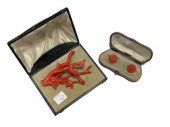 A Victorian branch coral brooch,
A Victorian branch coral brooch, 10cm long, in a fitted case for Phillips, 31 Cockspur St, London and a pair of carved coral studs/buttons of flowerhead form, cased
A Victorian branch coral brooch,
A Victorian branch coral brooch, 10cm long, in a fitted case for Phillips, 31 Cockspur St, London and a pair of carved coral studs/buttons of flowerhead form, cased -
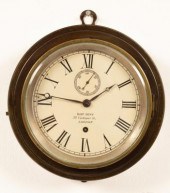 A bulkhead timepiece, the painted
A bulkhead timepiece, the painted dial signed Robert Dent mounted, Roman numeral dial marked 'Robt Dent 33 Cockspur St. London', No.1460, subsidiary seconds, the going barrel movement with lever platform in a circular bronze case, approximately 18cm in diameter (dial restored)
A bulkhead timepiece, the painted
A bulkhead timepiece, the painted dial signed Robert Dent mounted, Roman numeral dial marked 'Robt Dent 33 Cockspur St. London', No.1460, subsidiary seconds, the going barrel movement with lever platform in a circular bronze case, approximately 18cm in diameter (dial restored) -
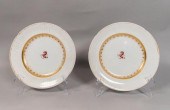 TWO 19TH CENTURY WEDGEWOOD
TWO 19TH CENTURY WEDGEWOOD PEARLWARE PLATESTwo 19th Century Wedgewood Pearlware plates. British, Early 19th Century. Scalloped plate with gilt edges and tracery, and a unicorn motif purported to be a family crest. Marked "T. Sharpus and Co. 13 Cockspur St. London." Both plates are heavily worn, with loss to gilt. 10" D
TWO 19TH CENTURY WEDGEWOOD
TWO 19TH CENTURY WEDGEWOOD PEARLWARE PLATESTwo 19th Century Wedgewood Pearlware plates. British, Early 19th Century. Scalloped plate with gilt edges and tracery, and a unicorn motif purported to be a family crest. Marked "T. Sharpus and Co. 13 Cockspur St. London." Both plates are heavily worn, with loss to gilt. 10" D -
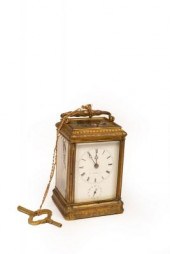 A gilt brass cased carriage clock
A gilt brass cased carriage clock with repeat mechanism and alarm, the white enamel dial signed Dent, 33 Cockspur St, 15.5cm high
A gilt brass cased carriage clock
A gilt brass cased carriage clock with repeat mechanism and alarm, the white enamel dial signed Dent, 33 Cockspur St, 15.5cm high -
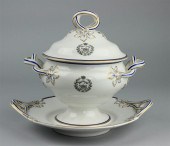 ENGLISH PORCELAIN ''BENGAL
ENGLISH PORCELAIN ''BENGAL ARTILLERY'' SAUCE TUREEN COVER AND STAND retailed by Sharpus and Co. / No13. Cockspur St. / London. pattern 382 with entwined looped branch handles terminating in flowerheads and leaf tips the handles and rims enriched in blue and gilt lines the cover sides and stand with crowned arms of the Bengal artillery - w:9.50 in. Provenance: Property of a southern lady
ENGLISH PORCELAIN ''BENGAL
ENGLISH PORCELAIN ''BENGAL ARTILLERY'' SAUCE TUREEN COVER AND STAND retailed by Sharpus and Co. / No13. Cockspur St. / London. pattern 382 with entwined looped branch handles terminating in flowerheads and leaf tips the handles and rims enriched in blue and gilt lines the cover sides and stand with crowned arms of the Bengal artillery - w:9.50 in. Provenance: Property of a southern lady -
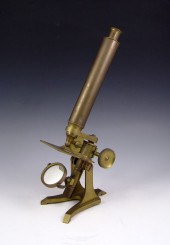 F. WEST LONDON BRASS MICROSCOPE:
F. WEST LONDON BRASS MICROSCOPE: All brass construction marked F. West Optician 32 Cockspur St. London. 13'' h. x 5 1/8'' x 3 3/4''.
F. WEST LONDON BRASS MICROSCOPE:
F. WEST LONDON BRASS MICROSCOPE: All brass construction marked F. West Optician 32 Cockspur St. London. 13'' h. x 5 1/8'' x 3 3/4''. -
 Books on the Battle of Fort Pulaski
Books on the Battle of Fort Pulaski and Partial ALS of Charles Olmstead 1p 6. x 9.5 in. Partial ALS signed by Charles Olmstead on Chas. H. Olmstead & Co. Bankers letterhead. Savannah n.d but 1880s from preprinted heading. Probably to Matthew Hopkins since he requests the addressee give his regards to Pattie (Hopkins' wife). Moderately toned and separating at folds.Hawes Lilla M. ed. The Memoirs of Charles H. Olmstead. Savannah (GA): Georgia Historical Society 1964. 8vo green cloth gilt spine 192pp. According to the introduction these Memoirs were written for Olmstead's daughters and gives a picture of the ante-bellum South and accounts of Civil War battles. He notes "The vacancy occasioned by the promotion of Edward Lawton I filled by the appointment of my dear old friend Matthew H. Hopkins to the adjutancy. At that time he was an officer of the Guards stationed on Green Island but he accepted the position came to me at once and from that time until the end of the war we were never separated except for a month or so in the Spring of 1864..All memories of army life are associated with him and the tie between us which was strong before knot out souls together indissolubly." (89-90) Excellent condition. Paper label taped to spine. Previous owner's margin notes and underlines.Gillmore Brig.-Gen. Q.A. Official Report to the United States Engineer Department of the Siege and Reduction of Fort Pulaski Georgia February March and April 1862. New York: D. Van Nostrand 1862. Papers on Practical Engineering No. 8. 8vo red cloth with gilt front 4 folding maps and plans 8 plates including frontis 96pp. Water stains and soil on covers about 1 in. at foot of spine missing paper label taped to top of spine.Wilson Adelaide. Historic and Picturesque Savannah. Boston Photogravure Company 1889. 8vo green cloth with gilt front and spine beveled boards 258pp. Frontis is foldout facsimile of James Oglethorpe's will. Corner bumping and wear to spine ends. Sunning of spine. Scattered foxing. Text block tight.Plus newspaper clipping from The Savannah Press 18 Aug. 1926 with Olmstead's account of the "Defense of Fort Pulaski" and photocopy of Olmstead's eulogy for Matthew Hopkins after his death in 1916.Fort Pulaski was constructed on Cockspur Island at the mouth of the Savannah River in the 1830s and 1840s. After the War of 1812 the United States planned a series of coastal defenses having just come through a war with the greatest naval power of the day. The Savannah River was of course the gateway to Savannah the largest port in Georgia. Early planning of the fort fell to recent USMA graduate Lt. Robert E. Lee. Beginning in 1829 Lee saw to the design of the fort and a system of drains and dikes so that the marshy island could support the massive walls of the 5-sided fort. In 1831 Lt. Joseph Mansfield took over the fort's construction which would take nearly a decade and a half.In January 1861 before Georgia's secession from the Union state troops occupied the fort so Union forces could not. They also began repairing the fort which was in bad shape after 15 years sitting empty. The state troops cleaned out the moat and began mounting the guns and when Confederate troops under Col. Charles Olmstead took command of the fort it was nearly restored and ready for action.When Federal troops captured Port Royal South Carolina General Robert E. Lee ordered Tybee Island and others abandoned and defenses concentrated at Fort Pulaski. Lee believed that Pulaski's walls could not possibly be damaged by bombardment from Tybee or any other point being nearly a mile away and he had designed the fort's nearly 8-foot thick walls.In this Lee was wrong. General William Tecumseh Sherman decided to take the fort by siege and put Capt. Quincy Gillmore (Eng. Corps) in charge of constructing defenses on Tybee and other smaller islands to keep the fort from being supplied. Gillmore's men constructed a series of artillery batteries working mostly at night to keep the defenders of the fort from discovering what they were doing. By April 9 Gillmore had 20 cannons and 14 mortars in position. The next morning he demanded the surrender of the fort to which Olmstead replied that he was there to defend it not surrender it. Just after 8am the batteries started a steady fire at the walls. It became apparent after a few hours that the shells from the rifled cannons would be able to break through the walls. Olmstead saw it too and by the next day after a couple of 30-foot holes were opened in the southeast wall shells were striking the interior of the fort. When at least one came close to one of the powder magazines Olmstead decided to surrender knowing that a magazine explosion would only mean the loss of many more lives and no victory. In less than 36 hours the impregnable fort was taken.Federal troops took over the fort and occupied it during the war effectively cutting off Savannah from the sea. It also served as a prison for captured Confederate troops.Charles H. Olmstead (1837-1926) was a member of the 1st Georgia Infantry (Olmstead's Regiment - one of upwards of 30 units calling themselves "1st GA Regt.") organized 31 May 1861. This unit spent most of its time in the Carolinas around Charleston until called out to halt Sherman's advance late in the war. Most of Olmstead's papers are in the Southern Historical Collection UNC.
Books on the Battle of Fort Pulaski
Books on the Battle of Fort Pulaski and Partial ALS of Charles Olmstead 1p 6. x 9.5 in. Partial ALS signed by Charles Olmstead on Chas. H. Olmstead & Co. Bankers letterhead. Savannah n.d but 1880s from preprinted heading. Probably to Matthew Hopkins since he requests the addressee give his regards to Pattie (Hopkins' wife). Moderately toned and separating at folds.Hawes Lilla M. ed. The Memoirs of Charles H. Olmstead. Savannah (GA): Georgia Historical Society 1964. 8vo green cloth gilt spine 192pp. According to the introduction these Memoirs were written for Olmstead's daughters and gives a picture of the ante-bellum South and accounts of Civil War battles. He notes "The vacancy occasioned by the promotion of Edward Lawton I filled by the appointment of my dear old friend Matthew H. Hopkins to the adjutancy. At that time he was an officer of the Guards stationed on Green Island but he accepted the position came to me at once and from that time until the end of the war we were never separated except for a month or so in the Spring of 1864..All memories of army life are associated with him and the tie between us which was strong before knot out souls together indissolubly." (89-90) Excellent condition. Paper label taped to spine. Previous owner's margin notes and underlines.Gillmore Brig.-Gen. Q.A. Official Report to the United States Engineer Department of the Siege and Reduction of Fort Pulaski Georgia February March and April 1862. New York: D. Van Nostrand 1862. Papers on Practical Engineering No. 8. 8vo red cloth with gilt front 4 folding maps and plans 8 plates including frontis 96pp. Water stains and soil on covers about 1 in. at foot of spine missing paper label taped to top of spine.Wilson Adelaide. Historic and Picturesque Savannah. Boston Photogravure Company 1889. 8vo green cloth with gilt front and spine beveled boards 258pp. Frontis is foldout facsimile of James Oglethorpe's will. Corner bumping and wear to spine ends. Sunning of spine. Scattered foxing. Text block tight.Plus newspaper clipping from The Savannah Press 18 Aug. 1926 with Olmstead's account of the "Defense of Fort Pulaski" and photocopy of Olmstead's eulogy for Matthew Hopkins after his death in 1916.Fort Pulaski was constructed on Cockspur Island at the mouth of the Savannah River in the 1830s and 1840s. After the War of 1812 the United States planned a series of coastal defenses having just come through a war with the greatest naval power of the day. The Savannah River was of course the gateway to Savannah the largest port in Georgia. Early planning of the fort fell to recent USMA graduate Lt. Robert E. Lee. Beginning in 1829 Lee saw to the design of the fort and a system of drains and dikes so that the marshy island could support the massive walls of the 5-sided fort. In 1831 Lt. Joseph Mansfield took over the fort's construction which would take nearly a decade and a half.In January 1861 before Georgia's secession from the Union state troops occupied the fort so Union forces could not. They also began repairing the fort which was in bad shape after 15 years sitting empty. The state troops cleaned out the moat and began mounting the guns and when Confederate troops under Col. Charles Olmstead took command of the fort it was nearly restored and ready for action.When Federal troops captured Port Royal South Carolina General Robert E. Lee ordered Tybee Island and others abandoned and defenses concentrated at Fort Pulaski. Lee believed that Pulaski's walls could not possibly be damaged by bombardment from Tybee or any other point being nearly a mile away and he had designed the fort's nearly 8-foot thick walls.In this Lee was wrong. General William Tecumseh Sherman decided to take the fort by siege and put Capt. Quincy Gillmore (Eng. Corps) in charge of constructing defenses on Tybee and other smaller islands to keep the fort from being supplied. Gillmore's men constructed a series of artillery batteries working mostly at night to keep the defenders of the fort from discovering what they were doing. By April 9 Gillmore had 20 cannons and 14 mortars in position. The next morning he demanded the surrender of the fort to which Olmstead replied that he was there to defend it not surrender it. Just after 8am the batteries started a steady fire at the walls. It became apparent after a few hours that the shells from the rifled cannons would be able to break through the walls. Olmstead saw it too and by the next day after a couple of 30-foot holes were opened in the southeast wall shells were striking the interior of the fort. When at least one came close to one of the powder magazines Olmstead decided to surrender knowing that a magazine explosion would only mean the loss of many more lives and no victory. In less than 36 hours the impregnable fort was taken.Federal troops took over the fort and occupied it during the war effectively cutting off Savannah from the sea. It also served as a prison for captured Confederate troops.Charles H. Olmstead (1837-1926) was a member of the 1st Georgia Infantry (Olmstead's Regiment - one of upwards of 30 units calling themselves "1st GA Regt.") organized 31 May 1861. This unit spent most of its time in the Carolinas around Charleston until called out to halt Sherman's advance late in the war. Most of Olmstead's papers are in the Southern Historical Collection UNC.
...many more examples with full details are available to our members - Learn more


